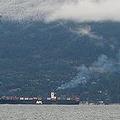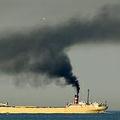 美國與加拿大共同合作,讓北美民眾能免受船隻排放有害物質污染,兩國也開創先例,要求國際海事組織將海岸線向外延伸200英里(約321公里)的範圍劃定為排放管制區。
美國與加拿大共同合作,讓北美民眾能免受船隻排放有害物質污染,兩國也開創先例,要求國際海事組織將海岸線向外延伸200英里(約321公里)的範圍劃定為排放管制區。
美國環保署長潔克森在紐沃港的聯合記者會上,協同美國海上防衛隊和紐澤西選派官員共同發表此項提議。美國與加拿大3月27日送交共同提案,明列在其專屬經濟海域內,大部分區域都應管制一氧化氮、硫氧化物和微粒物質的排放量。
美國環保署也順勢與聯邦機構如美國海上防衛隊、美國國務院和美國海洋暨大氣總署等提出因應方案;加拿大則以共同提議人的身份參與,並提出一份統合性的地域排放控制計劃。
被提列的排放管制區包括鄰近太平洋、大西洋及墨西哥灣沿岸,以及夏威夷主島的鄰近海域,而太平洋美國領域、夏威夷其他小型島嶼、阿留申群島和西阿拉斯加、波多黎各美國領土、維京群島和美加北極圈則不包含在內,但未來完成評估後仍有可能被列入管制區。
每年有超過93000艘船隻停靠在美國與加拿大的港口,除此之外,更多在排放管制區內運行的船隻雖然沒有停靠在美加的港口,但卻是在往墨西哥或南美洲的航線上。
美加兩國人口總計超過3億3千萬人,超過一半的人居住在太平洋和大西洋沿岸或是港口城市,例如溫哥華、洛杉磯、邁阿密和紐約。
 美加兩國將船隻排放廢氣所造成的人體健康危機和環境惡化,以量化方式進行分析後,顯示排放管制區的設立可以讓美加兩國在2020年時每年挽救8300位民眾的生命,以及減少340萬個類似氣喘等相關的呼吸道病例。
美加兩國將船隻排放廢氣所造成的人體健康危機和環境惡化,以量化方式進行分析後,顯示排放管制區的設立可以讓美加兩國在2020年時每年挽救8300位民眾的生命,以及減少340萬個類似氣喘等相關的呼吸道病例。
像油輪和貨船這類大型船隻,現在絕大多數還是燃燒重油做為動力,排放管制標準以目前全球的規定為基礎,要求燃料中的硫磺含量必須減少98%,微粒物質排放減少85%,氧化氮排放減少80%。
要實現這些減量目標,船隻必須在2015年開始使用含量不超過1000ppm的燃油,而新的船隻則需在2016年開始採用較先進的排放管制科技。
The United States and Canada have moved to protect North American residents from harmful ship emissions by becoming the first two countries to ask the International Maritime Organization to create an emissions control area around their coastlines extending out 200 miles (300 kilometers).
U.S. EPA Administrator Lisa Jackson announced the move at a joint news conference with the U.S. Coast Guard and New Jersey elected officials at Port Newark.
The United States submitted a joint proposal with Canada on March 27 to designate most areas of the coastal waters covered by their Exclusive Economic Zones for the control of nitrogen oxides, sulphur oxides, and particulate matter emissions.
The EPA led the U.S. effort to develop the proposal in coordination with federal partners such as the Coast Guard, State Department and the National Oceanic and Atmospheric Administration. Canada joined the U.S. as a co-proposer on the proposal, advancing a strategy for a coordinated geographic emissions control program.
The proposed emissions control area includes waters adjacent to the Pacific coast, the Atlantic/Gulf coast and the main Hawaiian Islands. Not included are the Pacific U.S. territories, smaller Hawaiian Islands, the Aleutian Islands and Western Alaska, the U.S. territories of Puerto Rico and the U.S. Virgin Islands, and the U.S. and Canadian Arctic, but they could be included in the future after assessments are done.
The U.S. and Canada typically see over 93,000 vessel calls at their ports annually. In addition, many more vessels operate in the proposed ECA that do not call on U.S. or Canadian ports, but instead are enroute to Mexico or South America.
The two countries have a combined population in excess of 330 million, over half of whom reside along the Pacific and Atlantic coasts and in port cities such as Vancouver, Los Angeles, Miami and New York.
The creation of an ECA would save up to 8,300 American and Canadian lives every year by 2020 and avoid some 3.4 million instances of respiratory ailments, such as asthma, according to an analysis the two countries conducted for this application that quantified the human health risk and environmental degradation posed by air emissions from ships operating in U.S. and Canadian ports and off their coasts.
Now, most large ships such as oil tankers and cargo ships burn dirty bunker fuel to generate power. Emissions control standards will require sulfur in the fuel to be reduced by 98 percent, particulate matter emissions by 85 percent, and nitrogen oxide emissions by 80 percent from the current global requirements.
To achieve these reductions, ships must use fuel with no more than 1,000 parts per million sulfur beginning in 2015, and new ships must used advanced emission control technologies beginning in 2016.



